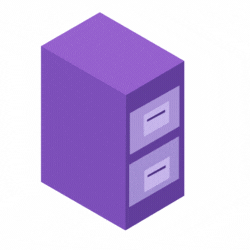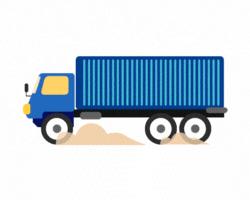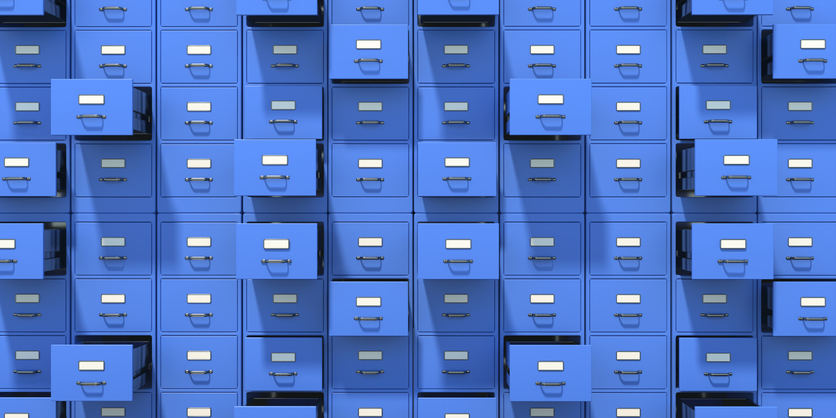10.07.2022
5 Step Guide to Digitizing Corporate Records
In a world of big data, digital information is proliferating each day. While many businesses have adopted new cloud-based technologies to manage the day-to-day, there’s another not-so-digital cloud of data lingering over them that has yet to be dealt with—their physical records.
Those endless rows of filing cabinets left to collect dust in the far reaches of office storage aren’t going anywhere, leaving business leaders with a lingering question: how do we efficiently and sustainably manage all of these paper records? In this article, you’ll find simple advice on how to digitize your corporate records and go paperless once and for all.
Let’s get started with the step-by-step basics:

Rather cut to the chase and get expert guidance? Contact us today >
1) Define the scope of your collection of documents
Before you can create a plan of attack, you need a full birds-eye view of what your physical records environment looks like. This includes the volume of your records, where they’re located, compliance requirements and more. Start by asking yourself the following questions.
Location
Are your records stored in filing cabinets? In bankers boxes? Are they all on-site at your corporate head office, or do other collections exist in storage facilities or at your field locations?
Volume
Do you have an accurate estimate of the volume of records you have in storage? As a general rule of thumb, one banker's box or linear square foot of storage (roughly that of a single filing cabinet drawer) holds approximately 1,800 pages.
Usage
Are these documents being utilized by anyone in the organization? How much of your collection (if any) can be recycled? What value exists within these stored files that you should make available digitally?
Compliance
Are there any compliance requirements you need to adhere to in this process? This question is particularly important for businesses in industries that have stricter regulatory standards, such as finance or insurance. If there’s a chance a document will be used in legal discovery or for evidence, it must adhere to compliance and chain of custody regulations.
2) Create a strategy for scanning your records
Once you’ve determined the scope of your records collection, you can make an informed decision about converting them in-house or hiring third-party support.

If your records collection is relatively small and you have sufficient internal resources, skills and processes in place, it may be feasible for you to digitize the records in-house. On the other hand, undergoing digital transformation can be a tremendous undertaking—and for some organizations, an expert partner is well worth the investment.
Here are some of the reasons choosing an expert partner could save you time and money:
Technology
If your records collection is large, it would be cumbersome for your in-house staff to scan one document at a time. Leading technology like our IBML scanner can accurately scan and index up to 430 pages per minute.
Expertise
Digitizing a records collection is so much more than scanning pages. It requires knowledge of digital file storage, metadata, cloud-based ECM technology, compliance, records retention and more. The right partner will guide you through every step of the process with ease.
Human Capital
It’s likely that your employees’ time isn’t best spent on tasks that aren’t directly related to their job duties—and digitizing a records collection isn’t a feat that can easily be done off the side of a desk. With outsourced resources, your project will be completed with care and in a timely fashion.
3) Get organized and prepare files for scanning
Transportation

Unless you're scanning your records on site, you'll need to arrange for secure transportation from storage. Working with WCD, we'll arrange to retrieve and transport your records to our secure scanning facilities in Calgary or Edmonton following a strict chain of custody process. Here, records are securely stored until the scanning project is complete.
Document preparation
Document preparation for scanning can include removing pages from binders, removing staples and other fasteners, folding down corners and ironing out wrinkled pages. If this all sounds too tedious, don't fret—our digitization experts can handle it all.
Document retention
Before the digitization process begins, you'll need to decide what you want done with the records post-scanning. Often, companies want records securely destroyed but in some cases, they need to be returned to their original format (including re-stapling, placing pages back in binders, etc.). Your account executive will discuss the options with you.
4) Decide how to digitally store and manage data
Do you already have an Enterprise Content Management (ECM) solution in place at your organization? If so, is it able to accommodate and effectively organize your new digital records collection? An ECM consultant will help you develop a strategy for storing and organizing this new information in a way that makes it easy for employees to access, search for and find information.
If you don't have an existing ECM solution, here are some of the factors to consider when choosing one:
Complexity of your information environment
Do you have several departments that each need their own repository, or are you a smaller business that needs a single place to store information? The higher the volume and complexity of your records collection, the more likely you'll need a more sophisticated platform.
Metadata requirements
What type of search functionality do you need to retrieve documentation? For some records collections, this could be as simple as the ability to search for a file name. For larger digital environments stored across systems, ECM technologies like M-Files can help you search for and locate information in a matter of seconds by pulling advanced metadata like keywords within a document.
Permission controls
Do you require advanced measures for granting access to documentation, or are you fairly lenient? For organizations with stricter governance policies that are looking to protect sensitive information, consider opting for an ECM system that has built-in controls.
5) Create a plan for day-forward records

As you organize records into an Enterprise Content Management (ECM) system, you'll want to develop a solid framework for your day-forward strategy. Put simply, a day-forward strategy determines how you will manage paper documents created from a certain date forward—mainly to prevent a new collection of physical documents from being created.
For some organizations, this is as simple as stating that any physical records created in the future will immediately be scanned and digitally retained in the new ECM system. This prevents costly records management and scanning projects in the future, and encourages staff to get accustomed to saving documents in a central, accessible location. Your plan should address standard processes and accountabilities for day-forward scanning.
Ready to go paperless?
WCD is a leading Canadian provider of document imaging and storage solutions. Discover ways we can help your organization go paperless once and for all by reading about our Information Solutions.



